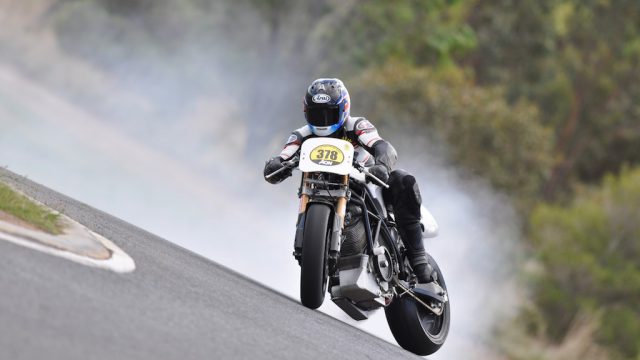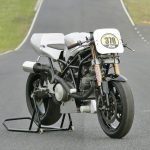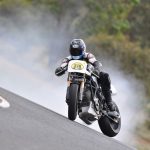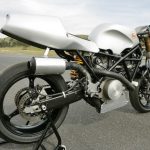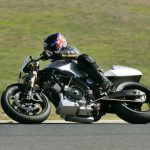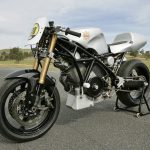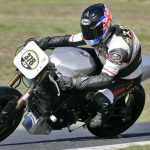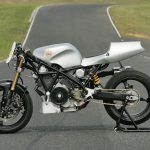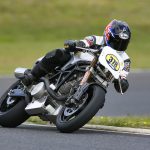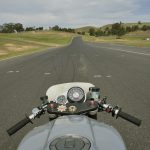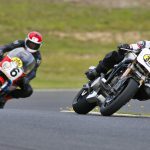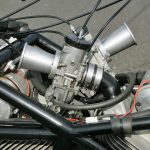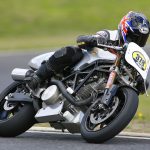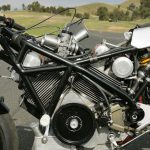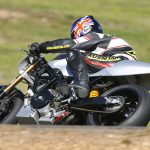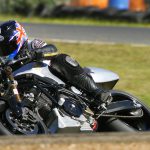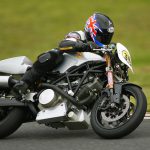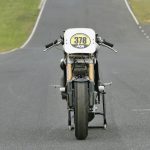First test of the latest of three Australian-built modern-day BSA V-twin specials
The acquisition of Britain’s historic BSA motorcycle brand last October by the $17.8 billion Indian industrial conglomerate Mahindra Group, one of the top 20 companies in India’s Fortune 500 index, inevitably has us wondering what kind of bike Mahindra will now develop to carry the BSA badge, whenever they get round to relaunching the marque in a process that’s inevitably being seen as a two-wheeled version of Tata’s hyper-successful takeover of Jaguar Land Rover.
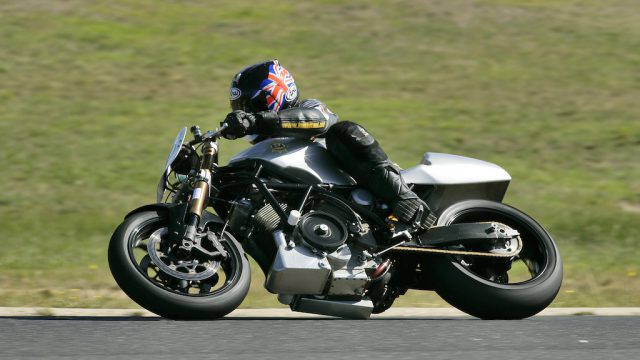
However improbably, Australian engineer Doug Fraser has anticipated answering that question by creating no less than three completely different V-twin tributes to the historic BSA marque in his Emu Engineering concern on the outskirts of Melbourne. With his own hands and with minimal assistance, he’s conceived and created three quite different V-twin motorcycles that he’d like to have seen the British firm that was once the world’s largest motorcycle manufacturer produce at one stage of its history or another. One is his so-called M46 late ’30s sports model, the middle one the B66 early-‘70s disc-braked roadburner – and the third in the shape of the E120R is the kind of bike that BSA might have made today as a naked Streetfighter, had it stuck around building bikes this long. Except it didn’t – well, maybe not until now….
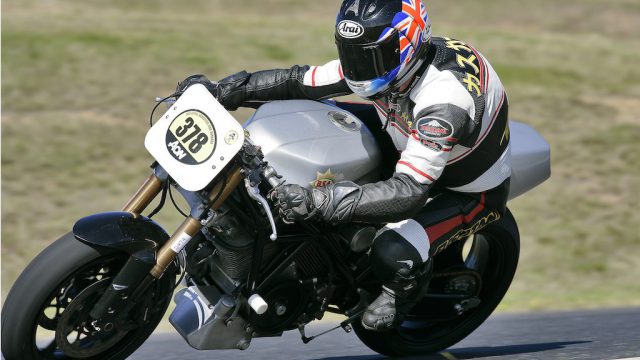
Doug Fraser is a toolmaker by trade, so his large but crowded suburban factory on the road to Phillip Island is packed with an array of lathes, grinders, milling machines and related equipment, all of which can also be used to manufacture a motorcycle from the ground up. But it’s fair to say that sixty-something Melbourne-born Fraser is somewhat smitten by vehicles Made in England. Parked outside are his company wheels, a 1970s Hillman Hunter workhorse that’s done over 900,000kms and is on its third body, while garaged inside the workshop is his daily driver, a V12 Jaguar E-Type Coupé of the same vintage, that’s done ‘only’ one-fifth of the Hillman’s mileage, with his original 1983 Hesketh V1000 motorcycle nestling in front of it.
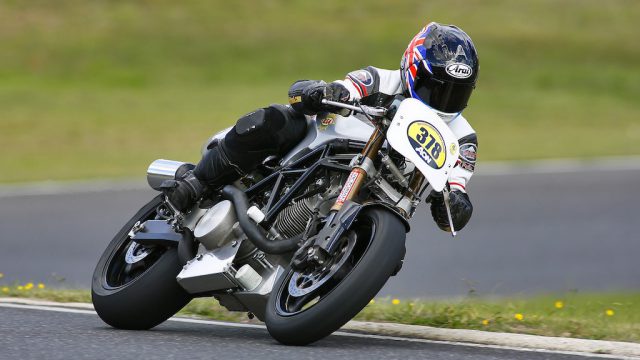
So what’s the fascination with the products of the Mother Country, Doug? “I was brought up in the era when the British motorcycle industry was well and truly flourishing,” says Fraser. “I like the way that their bikes were built, because as a toolmaker I can relate to the machinery that was used to make them. And I think they're pretty fine products, to the point that I'm a passionate believer in British motorcycles.”
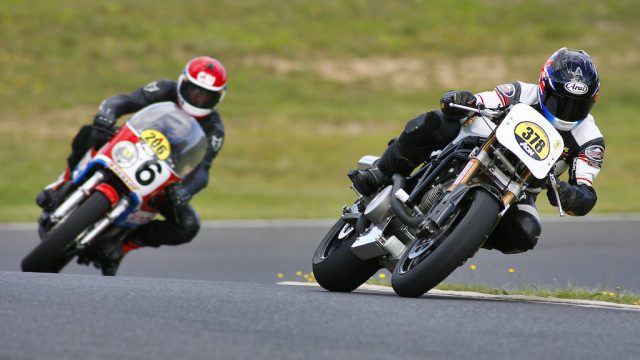
Doug Fraser is an especially big fan of the BSA Gold Star single, and owns several of them including the 500 Goldie with self-developed four-valve cylinder head that he’s raced successfully in Aussie Classic racing, or the bike on which he and his wife Jenny spent six weeks touring Britain and the Isle of Man in 2008, two-up with luggage. That’s dedication to the cause. But Fraser’s self-built trio of BSAs is quite unlike anything that ever rolled out of the Birmingham factory. “I’ve always liked BSA V-twins, even though they only built them from 1920 to 1938, and in spite of the fact they were known to be a little short-fused, while looking so nice,” says Doug. “I’ve never understood why BSA didn’t build a more modern version.” So now he’s gone and done just that, rounding out his tribute to BSA with the creation of the final bike in his BSA trilogy, designated the E120R. ”It was the logical follow-on to the other two, showing where BSA would be if they’d decided to keep going with the V-Twin into the modern era,” says Fraser. “Both of the others have lots of BSA parts in them, and they’re based on the styling BSA used in their period – but unfortunately BSA hasn’t been around since 1972, so we can’t really say what their bikes would have looked like today. So I’ve opted for a thoroughly modern design in creating what a modern BSA sportbike might have been, if BSA engineers had been able to employ today’s engineering solutions.”
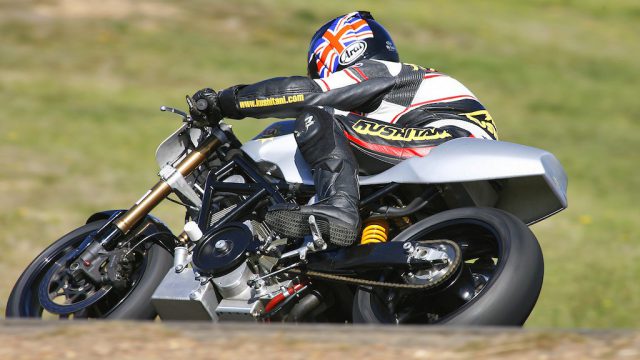
The result is powered by a meaty-looking air/oil-cooled 1194cc eight-valve dohc 75º V-twin dry sump motor measuring 100 x 76 mm, with narrow crankcases for extra stiffness, thanks to the hefty external Moto Guzzi-style bacon-slicer flywheel on the left side, surmounted by cylinders whose extensive finning maintains the same size and shape as the legendary BSA DBD34 Gold Star. ”With four-valve cylinder heads, I was concerned about heat build-up in and around the exhaust valves, so I’ve used oil to further cool the cylinder sleeves and exhaust ports,” explains Fraser, who plans to fuel-inject the motor which is presently fitted with rather small 38mm Amal Mk.2 Concentric carbs. These will be bored out to 42mm once initial development work is complete, though fitting MoTeC EFI is the eventual goal – conveniently, Australia's world-class engine management company is located less than 50km away from Emu’s base in Melbourne’s Eastern suburbs. And there’s provision in the castings for eventually fitting both an alternator and a starter motor to get the show on the road – for making a street legal Emu BSA 120R is very definitely on the agenda.

“I designed this as a true BSA Streetfighter derived from a sports model which could be ridden on the road, as well as giving a good account of itself on the racetrack,” says Doug. “I’ve allowed enough metal in the head castings for space to machine them to install single injectors at the bottom of the ports. These run a very distinct angle of downdraft, anyway, so it’s an ideal placement. But to get the engine set up and running properly, I’m using Amal carbs and twin self-generating SEM chain-saw magnetos from Sweden, then when we’re looking for more performance, we’ll switch to injection.” That’s exactly the same strategy adopted by Doug’s close eighbours, Ken and Barry Horner, in developing the fabulous Irving Vincent racers in their nearby hi-tech CAD/CNC-equipped factory just 10km from Emu Engineering HQ – must be something in the water! The Horners first used carbs for their serially successful post-Classic 1300cc racers, before switching to MoTeC EFI for the Daytona-winning Irving Vincent 1600cc ProTwin bike. “What Ken and Barry have done is really fantastic – they deserve real credit,” says Doug. “We’re just doing the best we can in a relatively low-tech machine shop compared to theirs, where the electric pencil sharpener beside my drawing board is the most high-tech design item! And we don’t use CNC to machine parts, but DMC – Doug Manual Control!”
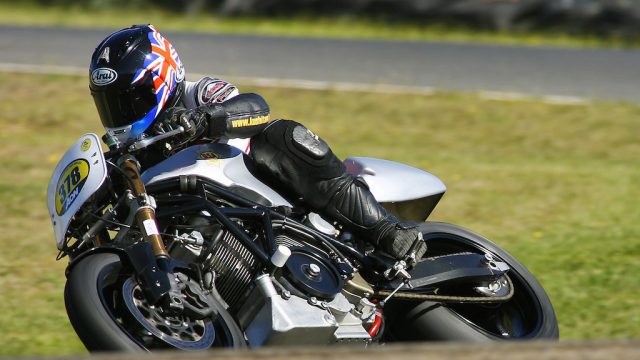
The Emu BSA’s narrow crankcases are vertically split, encompassing a one-piece plain-bearing crankshaft which Fraser himself machined up out of a single EN26 steel billet. That did take a bit of time, though – he started off with a 52kg lump of metal, and ended up with a crank weighing just 7.5kg. “There was a lot of swarf!” says Doug. The mainshaft of the crank is 40mm in diameter, and the assembly runs on two very large roller main bearings, plus a support bush on the far right hand side where oil is pumped into the crank. This runs a 50% balance factor, same as on Fraser’s other Emu BSA creations, and carries Pankl titanium conrods bolted-up side-by-side on a 53mm diameter big end, with forged Mahle pistons sourced from a flat-six Porsche 996RS delivering 11:1 compression, and running in Nikasil-lined Mahle sleeves. That billet crankshaft is pretty light, thanks to small semi-circular crank webs supplemented by the vintage-style outside flywheel on the left, which can be varied in weight to balance traction with acceleration – the present one weighs around two kilos, but Doug plans to machine up a lighter one for increased acceleration on a dry track, plus a heavier one for damp or slippery conditions. “Call it mechanical TC!” he jokes.
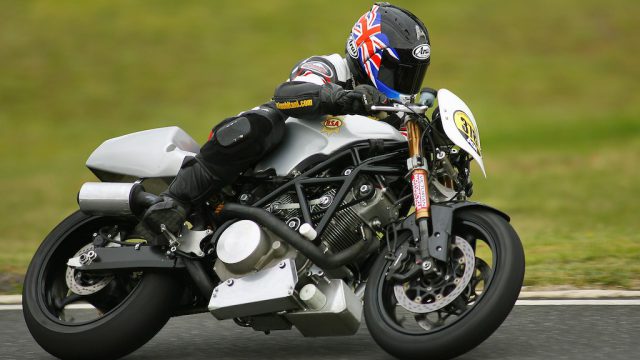
The E120R Emu BSA’s four-valve cylinder heads carry paired sodium-filled valves – 41mm inlets and 35.8mm exhausts, with 6mm stems and dual springs, all again sourced from Porsche – set at a flat included angle of 27º, with 15º on the inlet and 12º on the exhaust. These are operated by twin overhead camshafts per cylinder personally ground by Fraser himself out of E110 case-hardened steel to Porsche profiles, each operated by a separate 19mm belt driven via a common pulley mounted on a layshaft running off the crank. These cams run on plain bearings straight into the cam boxes, operating hydraulic radius-bucket tappets made by INA for Porsche, so although the cam boxes are quite high, there’s no tappet adjustment. Transmission is provided by a unit construction 6-speed Honda VTR1000 Firestorm gearbox with gear primary drive, which Fraser has cassette mounted to be fully extractable for speedy internal ratio changes – it takes less than 30 minutes to change a gear ratio, he claims. A Honda Fireblade clutch is fitted to deliver the appropriate larger primary drive gearing.
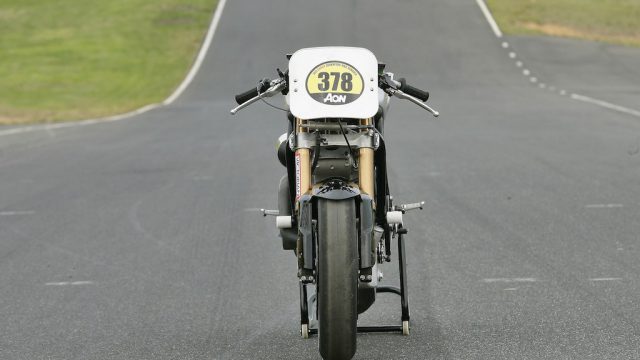
This beefy-looking motor is fitted in a Ducati-style fully triangulated chrome-moly tubular steel spaceframe weighing less than 10kg, using the engine as a fully-stressed load-bearing component. A modified Honda CBR600RR extruded aluminium swingarm pivots in the rear of the engine as well as in the spaceframe, for extra support, with the fully-adjustable Öhlins monoshock sourced from a Ducati 999S pivoting cantilever-style on the frame. The front end is essentially taken from a Suzuki GSX-R1000, with a fully-adjustable Kayaba fork set at a 24º rake, and 310mm front discs gripped by Tokico four-pot calipers – and the same Suzuki furnished both wheels, too, which Doug Fraser has shod with D208 Dunlop rubber. Wheelbase is a compact 1400mm, and the Emu BSA 120R weighs 168kg with oil but no fuel, split 52/48%. Fuel is contained in a modified Yamaha TRX850 steel tank, with the underside reshaped to clear the Emu BSA cam boxes.
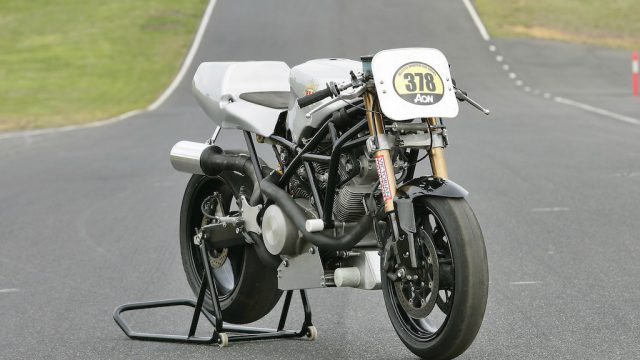
OK, now for the inevitable question: how much horsepower has Doug Fraser got so far in his ultimate Big-Twin Beezer? “At present, just 103 bhp at the rear wheel at 6,800 rpm – but I’m just getting started,” says Doug. “To have peak horsepower at that low a figure shows the engine is just not breathing hard enough. The reason it doesn’t want to go beyond 8,500 rpm at the moment is because it’s asthmatic – the carbs are way too small. I believe I can take the Amals out to 42mm, but that’s just not going to be big enough – I've got to be looking at 44-46mm at least, but Keihin don’t make flatslides that big, and I'm not overly keen on using CV carbs for performance. So eventually I must fuel inject it, which by definition would mean I’d fit bigger throttle bodies, and that way I’d be expecting around 120bhp at the rear wheel. But in the last 11 months, I’ve only been able to find nine months of time to work on it. I’ve actually had to put non money-making work aside for a while and concentrate on earning a living, before I can get back to it again!”
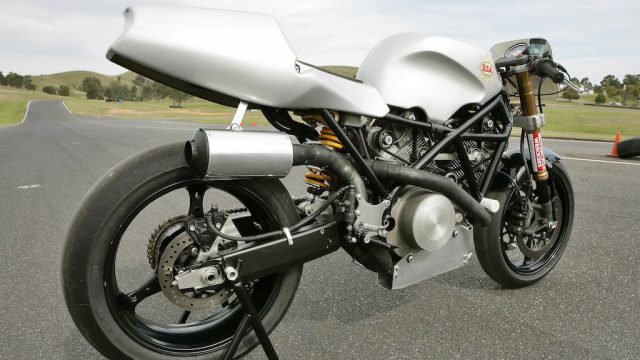
The chance for me to give its creator a shakedown progress report came at MA/Motorcycling Australia’s annual Broadford Bike Bonanza festival of two-wheeled sport run over each Easter weekend, held on the 2.16km hillside circuit north of Melbourne whose roller-coaster top straight would certainly allow me to get the measure of the Emu BSA Superbike’s performance potential, with its tight, twisty downhill section allowing a good examination of its handling. Except, Doug had only previously managed to run his newborn creation for a couple of laps at a wet race meeting two weeks earlier – enough to demonstrate that it would spin the back wheel in every gear, such was the copious amount of torque on offer. Still, that was enough for a proof-of-function test, so after five laps at Broadford just to warm the tyres and make sure everything was screwed on tight, Doug pitted and handed the bike to me.
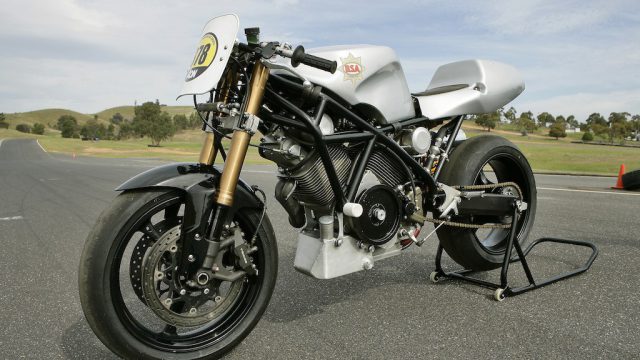
Doug Fraser is a little shorter than me, and the Emu BSA 120R’s close-coupled riding position was obviously tailored to suit him like a made-to-measure suit, but the snug stance wasn’t unduly cramped, just compact. And that’s the way the 75º V-twin felt out on track, infinitely tighter in build and tauter steering than the much rangier bevel-drive 90º L-twin Ducati I’d just been riding half an hour earlier, with its four-inch/100mm longer wheelbase. Alongside his undisputed engine-building skills, Doug Fraser knows how to create a pretty effective chassis, with neutral, balanced steering and an agile eagerness to change direction through Broadford’s downhill Esses. The Emu BSA’s fingertip steering let me flick it from side to side without excessive effort off the throttle, while powering around the sweeping uphill second-gear off-camber left-hander onto the main straight revealed a bike that absolutely did not push the front wheel as I wound on the power. It held exactly the line I’d chosen for it as I shifted up to third and then fourth, with the rear suspension soaking up the ripples on the exit while laying the BSA V-twin’s acres of torque to the tarmac.
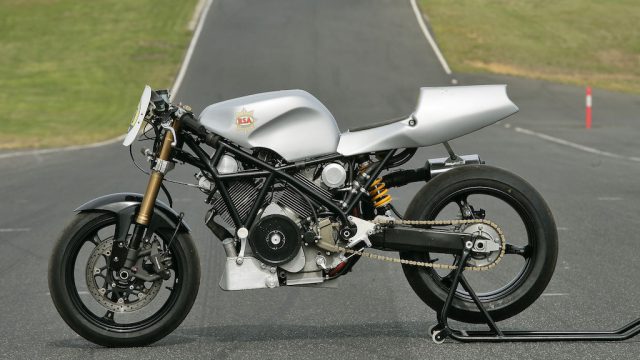
And the engine is indeed just as lusty and torquey as you’d hope a performance V-twin motor would be, with no real vibration in spite of not having a counterbalancer – KTM has to run one in its own 75º V-twin LC8 motors, so what does Doug Fraser know that the Austrians don’t?! Though the clutch was a little grabby, the six-speed Honda street-pattern gearbox worked as well as ever, and there’s an ultra-rideable power delivery which Doug says comes from the fact that there’s more than 100 Nm of torque from 3,500 rpm all the way to 7,200 revs. The BSA pulled strongly right off the 1,500 rpm idle speed, and would run OK up to my appointed 8,000 rpm redline and maybe beyond, but the last thousand revs were hard-won. I could tell it had stopped breathing hard if I held a gear and tried to run it much higher than seven grand, presumably thanks to the small 38mm carbs fitted, which are way too restricted for 600cc cylinders – Ducati ran a 42mm Dell’Orto on its works 350cc GP single, and the Honda VTR1000 Firestorm used 48mm Keihins, as the last big Honda sportbike to be fitted with carbs. So while it might struggle on top end performance at present – and Bradford was really too short to evaluate that properly – that can surely be resolved quite easily by fitting larger carbs or preferably EFI with at least 50mm throttle bodies. Till then, I think Doug’s unlikely to succeed in taking a bike with so much potential much further. However, the upside of that is that it accelerates like gangbusters with the smaller carbs fitted, with just a small hiccup around 5,000 rpm that was presumably either carburation or exhaust related, and it was very forgiving and responsive backing on and off the throttle through a series of tight turns. Now the trick will be to combine that with the outright performance this eight-valve V-twin is surely capable of.

For a first serious outing, Doug had guessed right on the suspension settings – I could trailbrake the BSA into the apex of a turn hard on the brakes, without excessive front end dive closing up the steering geometry, and making it feel like it wanted to tuck the front wheel. It felt nice, but above all predictable. Same thing braking hard at the end of either straight at Broadford, where the Suzuki brakes did an excellent job of stopping what even at prototype stage is a pretty light V-twin performance package. In spite of the short wheelbase by Superbike standards, thanks to the far from excessive forward weight bias there was no real instability through excessive weight transfer when braking hard, even one lap when I made a mistake shifting down one gear too many at the end of Pit straight, and got the rear wheel chattering as a result – no slipper clutch, see! It did pay to use a fair bit of engine braking to help out the Tokico brakes, though – just choose the right gear to do it in, and be ready for the considerable amount of inertia you feel when you back off the throttle, which presumably is down to the weight Fraser has chosen for the detachable outside flywheel. Still, I didn’t once get the rear wheel lifting and street-sweeping the tarmac.
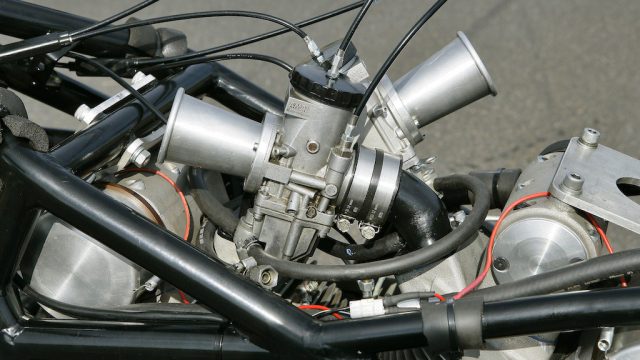
However, I did have the narrowest of escapes from crashing the fruits of Doug Fraser’s eleven months of hard work in my first session on the 120R! I’d already encountered the engine’s reluctance to rev out, managing only to pull a true fifth gear (of six) on the top straight. But I’d also discovered how sweet the Emu BSA was on the brakes, and how it’d hold a line while braking deep into the apex of the right-hander at the end of that straight. Then, one lap it happened. I downshifted three gears on the brakes as usual, and as I hit second gear while tipping into the apex of the bend, I suddenly felt the rear tyre step way, way out on me – I mean, BIG time! Fortunately, I had just enough warning to be able to catch it by countersteering, all the time willing myself not to touch the throttle or rear brake, and slow it with the front brake before running out of road – which I just managed to do while still staying upright, and on the tarmac, too. Phew! More by good luck than anything else I’d just managed to save it, parking the bike up after discovering its rear tyre was covered in oil. Yet the engine had still been running OK, so fortunately it hadn’t gone pop….
“The problem didn’t show up on any of the dyno runs I’d done, because the engine wasn’t put under load for long enough,” said Doug Fraser after profuse apology and due inspection. “It’s an issue brought about by too much crankcase pressure building up thanks to inadequate ventilation, and pushing out the crankshaft seals. But it’ll be OK if you don’t go over 6,000 rpm.” So I didn’t – and thus had a rewarding day riding this outstanding piece of Aussie inventiveness, after being reminded one more time – fortunately not the hard way! – of the risks of riding prototypes that are still work in progress. Still, it’s a tough job, but someone has to do it….

But, with his Emu BSA 120R V-twin racer, Doug Fraser has yet again demonstrated his resourcefulness and inventiveness in creating his own motorcycle from the ground up, all on his own – and this time a performance bike, which is an even bigger ask. But Doug Fraser has had plenty of practice at making Emus fly….!
